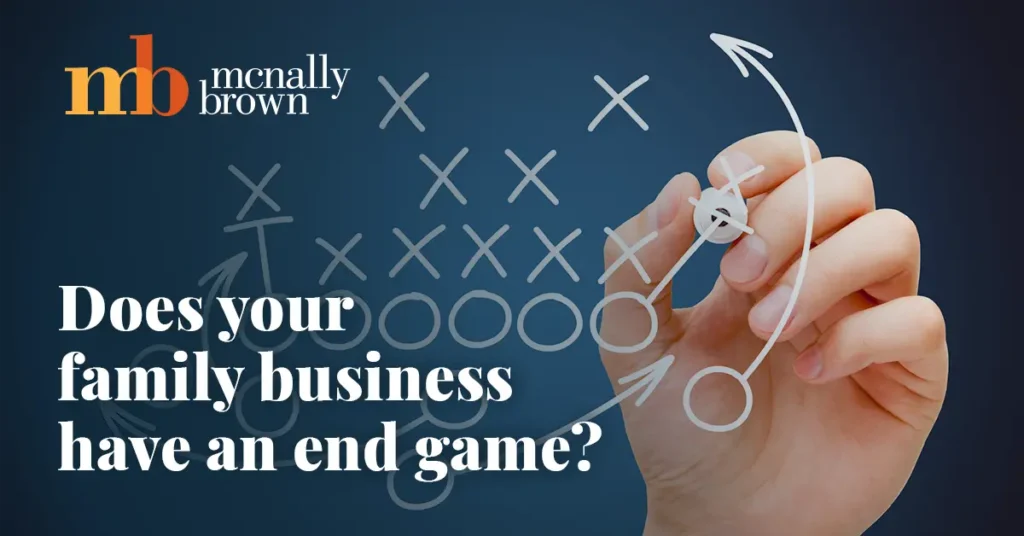Strategic Planning and Family Business
PART 3: Defining the End Game
Preamble
In this third and final installment* we explore how family legacy decisions can affect strategy and how good planning can mitigate risk in today’s rapidly changing business environment. For family business owners, strategic planning really begins and ends with a single powerful question:
Why do we choose to be in business together?
This then invites the family to ask: Are we in business out of a shared desire to sustain a specific business legacy? Or is it to provide employment and income for family members? Or is it really more about realizing a broader vision for the family, such as sustaining family wealth so that it may be deployed in a way that supports the values and beliefs that the family stands for?
How this question gets answered has a significant bearing on the context in which business families make decisions, and ultimately the nature and direction of such decisions.
You Can’t Stop Change
As stated earlier in this series, strategic planning involves answering the following key questions:
- What is our winning aspiration (vision & mission)?
- Where will we choose to compete?
- How will we win in our chosen market(s)?
- What capital and core skills are required?
Businesses face rapid rates of change due to product life cycles, technology shifts, and financial disruptions such as in 2008. A 2012 study by Innosight has shown the average lifespan of S&P 500 companies has reduced from 61 years in 1958 to 18 years in 2012. Based on these statistics 75% of those S&P 500 companies will not exist in 2027. The challenge for family businesses is being ready to adapt to changes in the business environment with speed and flexibility, so that family wealth is not destroyed.
But family expansion and life cycles also pose a challenge. The business strategy presented to the family must make sense both with regard to market opportunities as well as the risk and investment preferences of the different generations of the family shareholders. So, while the succeeding generation will be keen to invest for the future, the retiring generation may have significant cash needs to fund their sunset years. These opposing risk preferences call on management to strike a fine balance as they strive to achieve growth and sustainability in the enterprise.
As discussed in the first article in this series, the long term investment horizon of a business family can be a competitive advantage. However, this characteristic can become a liability if the family fails to recognize trends that suggest they are in a declining business. One successful owner in business for over 40 years once told us “you need to reinvent your company every five years”. Sadly, too many family businesses end up realizing too late that they ought to have changed lanes or simply exited years earlier.
Successful business families are able to shift their perspective, and accept that as stewards of the business they must always question why they are in the business they are in, even if it seems an affront to the founder’s vision and business legacy. There should be no sacred cows! When the family stakeholders think of their legacy beyond the terms of the business they are in, a far greater universe of opportunities opens up. The possible sale or exit from the business should be one of many options to be considered, with the end game being the preservation of family relationships and the wealth built over the generations. This requires the family to develop its own set of guiding principles, and couple them with a management team that is committed to systematic planning, objective thinking, and a commitment to openness with family stakeholders.
Putting It All Together
A business strategy is a living document, not something visited once a year then put back on the shelf to gather dust. All too often this is the case. Given the rapid rates of change in the business environment, it is more true than ever that businesses must be cognizant of all the factors that could change or disrupt the business model on which a company’s competitive strategy is based.
In effect, business management and shareholder families need to be aware not only of changes in the competitive environment, but also of changes with respect to shareholder preferences and the lifecycle of each individual. Consider the situation involving a 3rd generation family construction firm owned in equal measure by four brothers (all in their 50’s and 60’s) and their families. The shareholders were at odds regarding the future of the construction business. Two of the brothers felt that the market was mature and offered limited opportunities for profitable growth, while the other two wished to stay in the traditional business. Collectively, they had three choices before them: become more aggressive in their existing markets; expand to other markets; or, exit the business.
Ultimately two of the brother’s took full ownership and pursued a western expansion, taking on substantial debt in the process. The other two took their money off the table and deployed it in less risky assets. While the decision to stay in the business temporarily preserved a long established construction legacy, the company ultimately failed as a result of life cycle forces. One brother died, and the other fell ill, leaving the business without the strong leadership and stability it required to implement a transition to the next generation.
Conclusion
This unfortunate scenario highlights the delicate balancing act that family businesses often face. In this three part series we have discussed how family businesses can be the Secret Weapon of business success and how challenging it is to pass the business on to the next generation. To overcome this challenge there are some fundamental practices that can improve the likelihood of success such as developing a culture of open communication, developing and aligning family and business strategies and assessing the risks associated with the status quo. Ultimately the family needs to define what success is to them, be it to continue the legacy of the family business or define a new legacy in other ways that preserve family wealth.
Further Reading

Does your family business have an end game?
For family businesses, strategic planning really begins and ends with a single powerful question: Why are you in business? The answer to this question will affect the quality of decision making by business families.

The right way to sell a family business
For family businesses, strategic planning really begins and ends with a single powerful question: Why are you in business?


